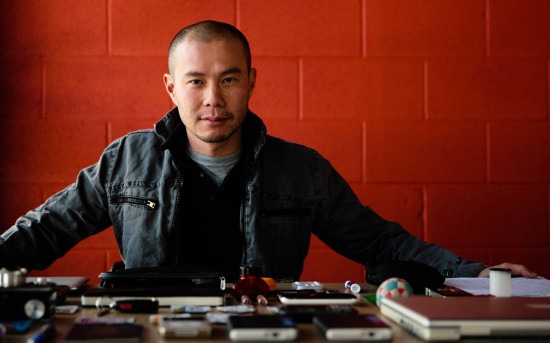Levi’s go-to meal planner talks nutrition for women

He’s counseled cycling royalty from Lance to Levi and is currently the sports physiologist for pro cycling’s Team RadioShack. But Allen Lim, PhD’s (@allencolim) passion for nutrition extends far beyond the male-dominated realm. He’s coached the UC Davis and CU Boulder women’s cycling teams plus the women on the resident national cycling team at the U.S. Olympic Training Center. Lim also serves up simple, targeted, and delicious recipes for high-performance food for athletes in his recently released book, The Feed Zone: Fast and Flavorful Food for Athletes, which he co-authored with Boulder celeb chef Biju Thomas. [Look for a yummy excerpt from this book coming soon on Women’s Movement.] Lim recently took a breather from his jetset schedule to sit down with Women’s Movement to chat about the specific nutritional needs of female athletes:
Women’s Movement: How do women’s nutritional needs differ from those of male athletes?
Allen Lim, PhD: There are some key differences that are important to point out. The first is that because of women’s monthly menstrual cycles, I find that they need to be more careful about getting enough iron so they don’t become anemic, especially heme iron from animal sources. Most female athletes I’ve worked with in the past do not eat as much animal protein as men—more women seem to be vegetarian or vegan. In those situations, I recommend they take a heme-based iron supplement (e.g. Proferrin ES) in lieu of eating animal-based proteins.
I’ve also found that female athletes tend to have much lower bone density compared to male athletes. This may be due to a number of factors, including a greater emphasis on weight control in women (though the same issues exist with men) that increase the level of stress or catabolic hormones in the body that can degrade bone. Another factor may simply be insufficient calcium intake, especially in both men and women who sweat a lot as there can be a significant calcium loss in sweat.
Finally, non-weight-bearing sports like cycling or swimming may not provide the stimulus for optimal bone density. With all of that in mind, I think it’s very important for female athletes to eat foods rich in calcium such as dairy products like milk or yogurt, green leafy vegetables, and enriched grains. In addition, it may be wise to have one’s vitamin D levels checked.
WM: What’s a solid pre-workout morning meal for women?
Lim: When I was working with the Celestial Seasoning’s Women’s Professional Cycling Team, the most common pre-race or pre-workout meal was a big bowl of oatmeal with apples, brown sugar, almond milk, and poached eggs cooked into the oatmeal. When I began working with men’s professional cycling teams, I fed them exactly the same meal. For men and women, the key is having something with a moderate- to low-glycemic index before a workout and to make sure there is at least 2.5 to 3 hours between that meal and the workout.
WM: What’s a healthier alternative to the ubiquitous energy bar?
Lim: A healthier alternative is something like sushi rice squished into a ball with other little fruits, nuts, or savory treats that you’d just enjoy while hanging out having a snack. The bottom line is that real foods and minimal ingredients always works better than complicated pre-packaged, processed foods. A lot of athletes I know love a little boiled new potato with some salt, olive oil, and a little grated Parmesan cheese.
WM: Can going gluten free help reduce the inflammatory load on the body and improve performance?
Lim: For some with a known wheat sensitivity, I think gluten free may really help. In addition, I think that during very intense competitions or training blocks when an athlete’s inflammatory load is already very high eating foods that are less inflammatory can really help and this may be where going gluten free is the most beneficial and powerful.
Kamagra oral jelly Online something to buy the most convenient way. He doesn’t demand from you any actions except how to visit the website. And in separate with goods necessary to you to put the end. To specify your address and to wait for the supplier to whom you will give money.


March 13th, 2012 at 11:45 am
Hi- What about those of us who don’t have 2.5-3 hours between a morning meal and our morning workout? During the work week, I’d have to get up at 3 a.m. What can/ should I eat if I only have 30 mins to max 1 hour before a 1 hour morning ride at 15-17pmh?